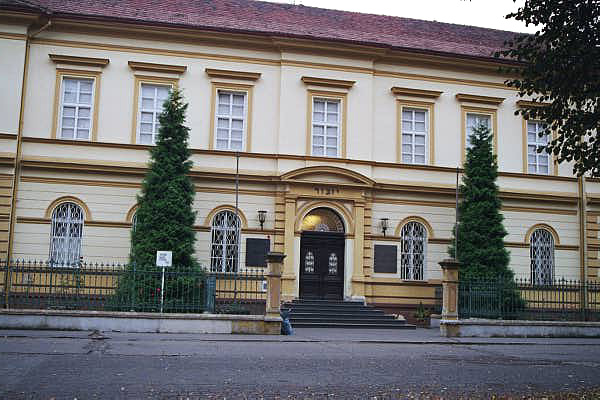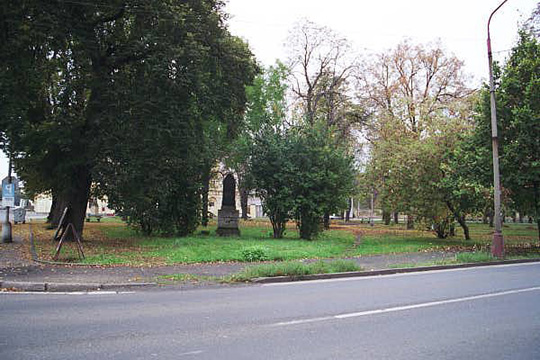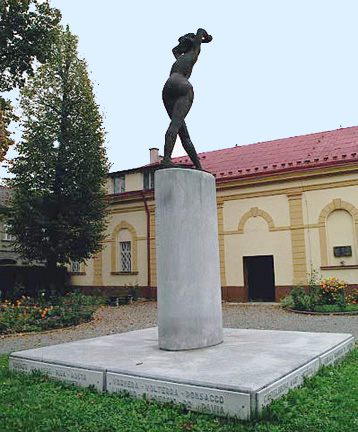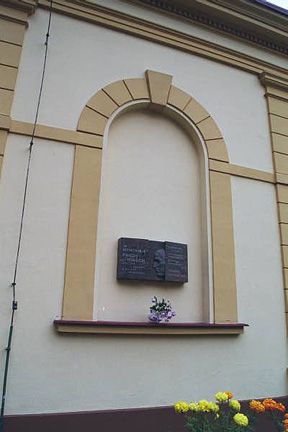The Ghetto Museum in Terezin
 Sign over Museum door
says Yizkor, the Hebrew word for Remember
Sign over Museum door
says Yizkor, the Hebrew word for Remember
The bus from Prague stops in Terezin
at the corner of Rathausgasse (Town Hall Alley) and Langestrasse
(Long Street). To start my tour of Theresienstadt, after stepping
off the bus, I turned right and walked along Rathausgasse, past
the current Town Hall, to the corner of Hauptstrasse (Main Street)
where I saw a sign directing me to the entrance to the Ghetto
Museum.
 Sign directs visitors
to the Ghetto Museum in Theresienstadt
Sign directs visitors
to the Ghetto Museum in Theresienstadt
The photo below shows Hauptstrasse with
Stadtpark (city park) in the background. The Museum is across
the street from the park.
 Stadtpark near the
entrance to the town of Terezin
Stadtpark near the
entrance to the town of Terezin
 Statue of Jan Hus in
the Stadtpark (city park)
Statue of Jan Hus in
the Stadtpark (city park)
Tour buses from Prague enter the town
on Hauptstrasse and the first thing that tourists see is the
city park; the western end of the park is shown in the photo
below. The Museum is across the street on the right and behind
the camera.
 First view of Theresienstadt
from tour bus
First view of Theresienstadt
from tour bus
There is a tiny store in the lobby of
the Museum building where one may purchase books or videos without
buying an admission ticket to the museum. (The book store did
not take credit cards or American money when I was there in 2000,
but there is a bank in Terezin which will change money.) I stopped
in at the museum and bought an excellent guide book which includes
a map of the town. The guidebook is entitled "The Terezin
Ghetto." It was written in 1991 by Ludmila Chladkova. The
important sites are numbered on the map
in the book and a short description of each historical building
is included.
The previous day I had gone on a guided
tour of The Small Fortress which had also included a brief visit
to the two museums in Theresienstadt, but I had seen very little
of the town.
The largest of the two museums, shown
in the photograph at the top of this page, was the first building
that I had seen when the tour bus entered the town at the northwest
end of Hauptstrasse. Called Ghetto Museum, it was dedicated on
October 17, 1991, the 50ieth anniversary of Nazi's decision to
the deport Jews from the Greater German Reich to the Theresienstadt
ghetto. Former prisoners of Theresienstadt, who survived the
ghetto or the death camps, came from all over the world to participate
in the opening ceremonies.
Before the Nazis decided in October 1941
to turn the old military garrison town of Theresienstadt into
a Jewish ghetto, the museum building was used for a school. During
the period when Theresienstadt was a Jewish ghetto, the museum
building was originally known as L417; it was used to house boys
between 10 and 15 years old. After the war, when the former residents
of Theresienstadt were allowed to return to their town in 1946,
the building again became a school.
After the Allied victory in World War
II, Czechoslovakia became a Communist country under the domination
of the Soviet Union. In all the post-war Communist countries,
there were monuments and museums erected in honor of the anti-Fascist
resistance fighters, but not much was said about the suffering
of the Jews, and few memorials were built in their memory during
that period. During the Communist regime, the "Museum of
Czechoslovak Police and Revolutionary Traditions of the Northern
Bohemian Region" was established in this building in honor
of those who fought the Fascists in the ideological war that
ended with most of Eastern Europe becoming Communist.
With the fall of Communism in 1989, the
museum had to be completely revamped to throw out the Communist
propaganda and replace it with the historical account of the
Nazi's Final Solution to the Jewish Question. According to the
museum guidebook, "its interiors had first to be freed from
its pretentious tastelessness and garishness. Today's solemn
and austere interiors are part of the overall image that the
planners intended to create."
The Communist propaganda in the old museum
was replaced with new exhibits depicting the daily life of the
Theresienstadt ghetto and its role as a transit center from which
Jews from Czechoslovakia, Germany, Austria, the Netherlands,
Hungary, and the city formerly known as Danzig were deported
to the death camp at Auschwitz and other concentration camps
in the East.
At the museum store, I purchased another
book entitled "Ghetto Museum Terezin" written by PhDr.
Vojtech, CSc, Ludmila Chladkova, and PhDr. Erik Polak, CSc. According
to this book, the boys' barracks in L417, which is now the Ghetto
Museum, had its own self-administration, which was the so-called
SKID. This barracks was under the supervision of Professor Valtr
Eisinge, who was transported in September 1944 to Auschwitz where
he died. His barracks also had an emblem and an anthem; the boys
published their own newsletter, called Vedem, for almost two
years.
The Ghetto Museum has a courtyard which
was the former playground of the school; it is now a Memorial
to the Children of Theresienstadt. The photograph below shows
a statue by Italian artist Emilio Greco and a Star of David which
have been placed there. On the walls in the background are memorial
plaques; the statue of a naked woman is shown in close-up in
the second photograph below.

Memorials in the courtyard
of the Ghetto Museum
 Statue of naked lady
by Emilio Greco
Statue of naked lady
by Emilio Greco
 Plaque on wall of Ghetto
Museum
Plaque on wall of Ghetto
Museum
|